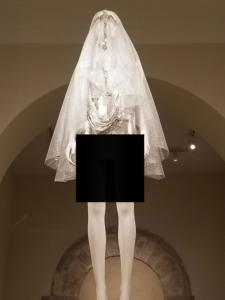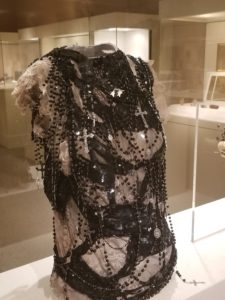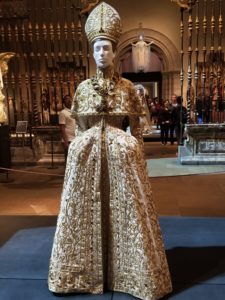It is one of the oldest tricks in the book. Those who cannot accept the grandeur of the truth will always look for ways to mix it with error. Those who cannot stand the splendor of beauty will find ways to blend it with ugliness or even the horrendous. For those that cannot bear the integrity of morality, it can be mitigated by adding a little sin.
The best way to attack any objective truth has never been frontal but always to water it down to insignificance.
And the trick never changes. The secret is to get the right mix. Too much evil can lead good people to protest and thus ruin the game. However, just enough of everything will provide the weak with the perfect excuse: a little bad makes the good more palatable to the masses.
These will further argue that the presence of ugly things will serve as the honey pot to attract wayward people who might then be exposed to beautiful things and possibly change their lives.
A Controversial Show
This seems to be the tactic of the Metropolitan Museum of Art’s new exhibition about the influence of the Catholic Church on high fashion, Heavenly Bodies: Fashion and the Catholic Imagination. It is a mixture of a few marvelous, sacred vestments loaned to the museum by the Vatican (in separate galleries) and a massive display of garish religious-themed fashion ensembles provided by the world’s most prestigious (and immoral) fashion houses.
The exhibit will run from May to October (the Fatima months). It is generating protest from many Catholics offended by its sacrilegious portrayal of religious themes. However, many others are calling for tolerating a lot of the bad as a means of exposing others to the little good.
Objectionable Items in the Collection

There are plenty of objectionable items in this exhibit to mix with the beautiful.
No one, not even its many rave reviewers, will deny that the exhibit has openly offensive and even blasphemous items, gravely contrary to the Catholic Church. Most will admit, for example, that the rosary-covered bondage mask is exceedingly offensive.
What Does Saint Thomas Say About Immigration?
Even in these days of moral relativism, the extremely short mini-skirted mannequins and their tight, sheer or revealing dresses (see left) present clothing that is immodest and offensive. Such representations are clearly against the norms of Catholic modesty. This is also consistent with the fashion world that has done so much over the decades to destroy Christian morals. Many of its items in the exhibit are no exception to this rule.
All these deplorable things exist, the exhibit promoters admit, but there is also so much “beautiful” religious imagery placed on top of these offensive fashions as to render any objection irrelevant. They claim the exhibit raises “fascinating questions” that lead people to think about religion without hostility. In fact, some will even argue that these shows are needed as a way to dialogue and engage with the other side.
Indeed, this has been the argument of prominent Catholic churchman including Cardinal Timothy Dolan and Fr. James Martin, S.J. who have pulled out all stops to promote the exhibition. The objectionable things are minor—they say—compared to the (unquantifiable) greater good to be gained by the exhibition. They claim it represents an opportunity the Church should not miss.
The Nature of Beauty
Such a position denies the nature of beauty and art. The role of art is to present the splendor of the truth not the masking of error.
What does Saint Thomas Aquinas say about Marriage?
Beauty by itself is a much more efficient attraction to people since it corresponds to human nature and the great desire to know God, the Absolute Beauty. Beauty does not need the objectionable to lead people to it. Sublime things overawe people and awaken a desire for more sublime things. Beauty on its own will attract much better than counterfeit items that mimic and mock it.
Indeed, anything is possible with God’s grace. The stark contrast between good and evil has often led to conversions. However, these graces occur despite evil not because of it. One cannot promote a scandalous exhibit based on the remote possibility that people might change their lives. In this case, the unlikely end justifies an iniquitous means.
Putting the Sacred at the Service of the Profane
The exhibit promoters commit yet another error of contradiction by affirming that something objectionable and beautiful can exist in the same item.

They seem to believe that the mere existence of religious symbols on fashion items is enough to make them beautiful. And thus, a cross emblazoned upon a mini-dress somehow makes the dress morally acceptable. A blouse full of rosaries (see left) becomes holy by the objects irreverently placed on it. A pierced bleeding heart with a grotesque ribbon of blood winding down a dress allegedly makes it sacred.
This use of symbols and images supposedly shows the profound “influence” of the Church upon fashion. However, there is a big difference between influence and mockery.
By definition, influence is the power of producing an effect through indirect ways. In this case, the Church’s influence on fashion should have the desired effect of reflecting the reverent use of Church themes respecting their sacredness and function. It should also reflect the spiritual values that are contained in those themes.
Instead, what is presented is properly speaking a mockery, which by definition, is an insincere, contemptible, or impertinent imitation. At this exhibition, nothing is sacred. The fashion world merely expropriates holy things and puts them at the service of the profane and unholy.
The Church and the Exhibit: An Impossible Coexistence

Everyone knows that the high fashion world of glitterati, jet-set figures and Hollywood stars exhibits the worst, tabloid-selling moral behavior. It is no secret that fashion designers are at the cutting edge of the sexual and transsexual revolutions. There is nothing Catholic about this world of sensuality, immodesty and frenzied unrestraint. This world has proven time and again that it is no friend of the Church.
The Heavenly Bodies exhibition is all about forcing an impossible coexistence upon two diametrically opposed worldviews. It is about making icons and crosses adorn scantily clad bodies, not altars consecrated to God.
It presents a bizarre postmodern world, in which things are disconnected from their context and function. A rosary is turned from a devotional object to a gaudy trinket. Sacred Heart pendants are made into necklace ornaments amid ample cleavage. Liturgical vestments normally dedicated to the worship of God are re-imagined as lady’s evening gowns. Bishops’ cassocks, pectoral crosses, and miters, symbols of spiritual authority, are reconfigured into designer dresses. Amid it all, there are also beautiful Vatican papal vestments in separate galleries that are supposed to be the inspiration for these fashion aberrations that actually mock them.
Thus, the effect of the exhibition is surreal. If the two worlds were kept separate, the result would at least be logical and consistent. However, when the two are forced together in the fashion items, everything is turned upside down and made to fit into a macabre drama where nothing makes sense, and anything is possible. Everything co-exists together, on equal footing, at the Heavenly Bodies exhibition.
And that is why Catholics must protest. More than any single object on display, it is this forced coexistence of two clashing worldviews that makes it so sacrilegiously unacceptable.
[like url=https://www.facebook.com/ReturnToOrder.org]
As mentioned, there is nothing new about this maneuver to mix truth and error, virtue and sin, beauty and ugliness. It is one of the oldest tricks in the book. Throughout the long history of the Church, there have always been those inside and outside the Church who have sought to “build bridges” to mix the two irreconcilable sides. These bridges merely smooth the way to an all-out assault. Such dialogues have always ended in defeat, persecution and tyranny for the Church. And so it will also be now.
Between the Church and modern world with its immoral high fashions, there is an impossible coexistence. That is why the Met’s exhibition must be opposed.


